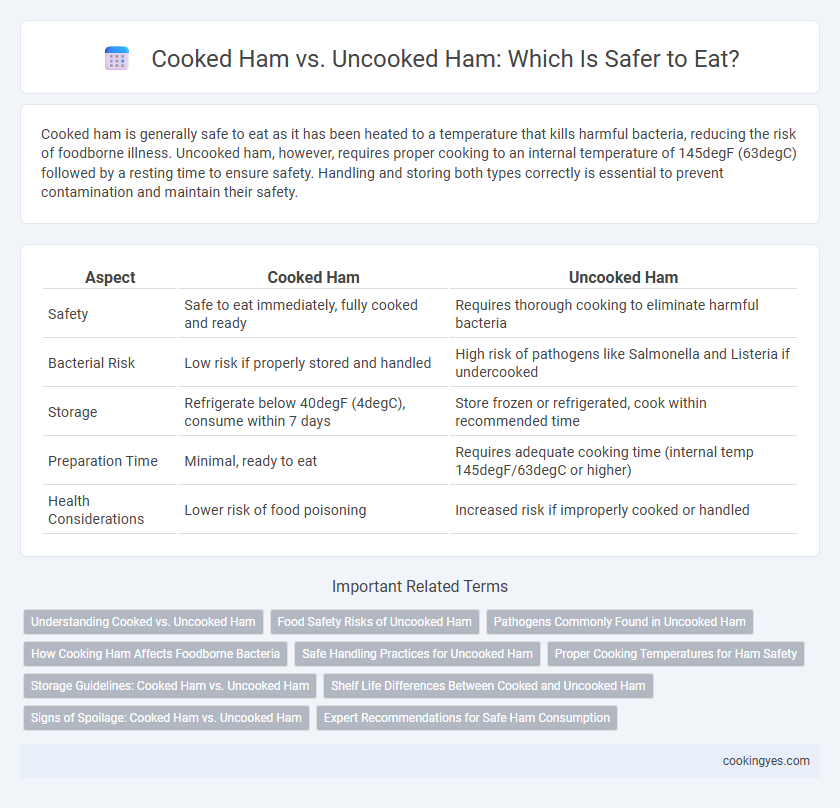Cooked ham is generally safe to eat as it has been heated to a temperature that kills harmful bacteria, reducing the risk of foodborne illness. Uncooked ham, however, requires proper cooking to an internal temperature of 145degF (63degC) followed by a resting time to ensure safety. Handling and storing both types correctly is essential to prevent contamination and maintain their safety.
Table of Comparison
| Aspect | Cooked Ham | Uncooked Ham |
|---|---|---|
| Safety | Safe to eat immediately, fully cooked and ready | Requires thorough cooking to eliminate harmful bacteria |
| Bacterial Risk | Low risk if properly stored and handled | High risk of pathogens like Salmonella and Listeria if undercooked |
| Storage | Refrigerate below 40degF (4degC), consume within 7 days | Store frozen or refrigerated, cook within recommended time |
| Preparation Time | Minimal, ready to eat | Requires adequate cooking time (internal temp 145degF/63degC or higher) |
| Health Considerations | Lower risk of food poisoning | Increased risk if improperly cooked or handled |
Understanding Cooked vs. Uncooked Ham
Cooked ham has been fully heated to a safe internal temperature, eliminating harmful bacteria and making it ready to eat without further preparation. Uncooked ham, often referred to as raw or fresh ham, requires proper cooking to at least 145degF (63degC) with a rest time of three minutes to ensure safety. Understanding these differences is crucial to prevent foodborne illnesses associated with undercooked pork products.
Food Safety Risks of Uncooked Ham
Uncooked ham carries significant food safety risks due to its potential contamination with harmful bacteria such as Listeria monocytogenes and Trichinella spiralis, which can cause severe illness. Proper cooking of ham to an internal temperature of 145degF (63degC) followed by a rest period ensures the elimination of these pathogens, making it safe for consumption. Consuming uncooked or undercooked ham increases the likelihood of foodborne illnesses, necessitating strict adherence to cooking guidelines.
Pathogens Commonly Found in Uncooked Ham
Uncooked ham often harbors pathogens such as *Listeria monocytogenes*, *Salmonella*, and *Clostridium perfringens*, posing significant food safety risks. These bacteria can cause severe foodborne illnesses if the ham is improperly handled or consumed raw. Cooking ham to an internal temperature of 145degF (63degC) effectively eliminates these pathogens, ensuring the meat is safe to eat.
How Cooking Ham Affects Foodborne Bacteria
Cooking ham effectively eliminates harmful foodborne bacteria such as Listeria monocytogenes and Salmonella, significantly reducing the risk of foodborne illness. Uncooked ham, including raw or only cured varieties, can harbor pathogenic bacteria that survive without proper heat treatment. Ensuring ham reaches an internal temperature of 145degF (63degC) followed by a resting time is critical for safe consumption and preventing bacterial contamination.
Safe Handling Practices for Uncooked Ham
Uncooked ham requires strict safe handling practices to prevent bacterial contamination, including proper refrigeration at or below 40degF (4degC) and thorough cooking to an internal temperature of 145degF (63degC) followed by a three-minute rest time. Cross-contamination risks demand separate cutting boards and utensils for raw ham, and hands should be washed with soap before and after handling. Ensuring these safety measures minimizes the presence of pathogens like Salmonella and Listeria, protecting against foodborne illness.
Proper Cooking Temperatures for Ham Safety
Cooked ham is ready-to-eat and has been heated to a safe internal temperature of 140degF (60degC) or higher, effectively eliminating harmful bacteria. Uncooked ham requires thorough cooking to an internal temperature of at least 145degF (63degC) followed by a three-minute rest to ensure safety from pathogens such as Listeria monocytogenes. Using a food thermometer to verify these temperatures is crucial for preventing foodborne illnesses associated with ham consumption.
Storage Guidelines: Cooked Ham vs. Uncooked Ham
Cooked ham should be stored at or below 40degF (4degC) and consumed within 3 to 5 days to prevent bacterial growth. Uncooked ham, typically requiring curing or cooking before consumption, can be refrigerated for up to 7 days or frozen for several months to maintain safety and quality. Proper storage of both cooked and uncooked ham minimizes the risk of foodborne illnesses by controlling temperature and exposure time.
Shelf Life Differences Between Cooked and Uncooked Ham
Cooked ham typically has a shorter shelf life than uncooked ham due to its higher moisture content and exposure to heat during processing, which can promote bacterial growth if not stored properly. Uncooked ham, often cured or smoked, benefits from preservation methods that extend its shelf life by inhibiting microbial activity and enzymatic spoilage. Refrigerated cooked ham usually lasts 3 to 5 days, whereas uncooked cured ham can last several weeks or even months when kept at the recommended temperatures, enhancing safety and quality over time.
Signs of Spoilage: Cooked Ham vs. Uncooked Ham
Cooked ham typically exhibits signs of spoilage such as a sour or off odor, slimy texture, and discoloration, often turning gray or green. Uncooked ham may show spoilage through a sticky or tacky surface, foul smell, and mold growth on the exterior. Proper refrigeration and adherence to expiration dates are critical to preventing bacterial contamination in both cooked and uncooked ham.
Expert Recommendations for Safe Ham Consumption
Experts recommend consuming cooked ham over uncooked ham to reduce the risk of foodborne illnesses caused by bacteria such as Listeria monocytogenes and Salmonella. Cooking ham to an internal temperature of 145degF (63degC) followed by a three-minute rest period ensures pathogen elimination and safe consumption. Uncooked ham, unless properly cured and stored according to USDA guidelines, poses higher safety risks and requires careful handling to prevent contamination.
Cooked ham vs uncooked ham for safety Infographic

 cookingyes.com
cookingyes.com